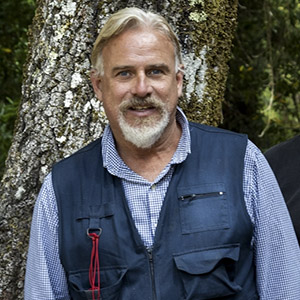There are several products that have been tested for controlling cypress canker. The following paper maybe the most useful one to compare products.
Della Rocca, G., Di Lonardo, V., Danti, R. 2011. Newly-assessed fungicides for the control of cypress canker caused by Seiridium cardinale. Phytopathologia Mediterranea. 50 (1), pp. 65-73.
The most effective active ingredients for preventive treatments appear to be Azoxystrobin and thiophanate-methyl.
A good approach to slow down the disease may consist of:
1) Cutting down infected trees to reduce the chance of contagion. If only a few tips are infected, prune branches rather than take down the entire tree.
2) Cut down all Leyland cypress as it is a major vector of the disease.
3) Treat remaining healthy trees with products containing azoxystrobin (an active ingredient less toxic than thiophanate-methyl).
Take the following precautions when using local acorns for oak reforestation projects in areas impacted by SOD to help minimize pathogen spread.
- Place acorns in a 10% dilution of bleach for 10 minutes then rinse twice with tap water.
- Make sure volunteers’ shoes are free of soil, mud, and organic material.
- Be sure tools being used are clean and free of soil, mud, and organic material.
Phosphonate injection treatments to help prevent sudden oak death infection of susceptible oak species (coast live oak; California black oak, Shreve’s oak, and canyon live oak), if applied in the fall (after October 30th ), need only to be applied once every other year (biannual frequency). If your first phosphonate treatment is in the spring, then treat again in the fall (after October 30th) and then treat once every other year.
If applying phosphonate as a bark application in conjunction with the surfactant PentraBark®, then one fall treatment each year is the prescription. If you apply it the first time in the spring, apply again in the fall after October 30th and then apply again in the fall of each year (after October 30th).
The most important part of ensuring that tools will not spread SOD is to be sure that no organic debris or soil is present on the tools. This applies to all portions of each tool, including parts that may not be visible (like the return of a chain in a chainsaw or the interior of a tree chipper). For more information on cleaning tools and equipment, go to https://nature.berkeley.edu/garbelottowp/?p=1208.
When looking at SODmap, you may wonder if P. ramorum-positive trees are close enough to pose a threat to trees on your property. Use the free App SODmap mobile to get the answer. Just tap the App risk function and it will tell you whether infected trees trees are within 200 m (high risk) or 1,000 m (moderate risk). If infected trees are further than 1,000 m, risk is typically low. Alternatively, you can use Google Earth, tapping the icon with a “ruler” on the top bar. Click your mouse on the closest infected tree and then move the mouse to your property. Be careful to actually move the mouse all the way to an oak tree within your property. The mouse should be drawing a line when you go from the infected tree to your oak. When you click the mouse again on top of the oak on your property, the ruler will tell you the distance. The following is suggested:
1- As the crow flies, measure from any infected tree to any oak of interest.
2- Repeat the measurement process using 3 different infected trees that appear to be close to your property.
3- If distance is slightly higher than 200 m (high risk) or 1,000 m (moderate risk), but your property is downhill and/or downwind, you may still consider your oaks to be at risk.
It is always advisable to first have a tree tested before removal to be sure P. ramorum is present. If you are noticing symptoms in spring, attend a nearby SOD Blitz for information on sampling and lab submissions. For more information, go to sodblitz.org.
Bay shoots do not carry P. ramorum because the pathogen is not systemic in bay. Each leaf is infected independently. Additionally, there is no root infection in most P. ramorum hosts, particularly California bay laurel. However, when bays re-sprout, they may be re-infected.
When treating oak trees with phosphites to help prevent SOD, it may be beneficial to apply the topical treatment to bark that is dry. Rain occurring after the treatment (even immediately after) does not affect the application. If injecting phosphites, it may be better to avoid rainy days, as lower evapotranspiration is often documented for trees in such conditions. Lower evapotranspiration rates may result in poor tree absorption of phosphites.
Note: Topical treatments are most effective when applied in the fall, from November to early December. Injections should only be performed from fall to early winter.
Survival of P. ramorum (SOD pathogen) in wood chips depends on a few factors:
- Were the chips allowed to become wet?
- What size are the chips?
- Is green waste present?
- What time of year was the wood chipped?
- Where in California are the chips located?
Chips that are piled wet or tarped and include infected green waste (e.g. bay laurel leaves) may support pathogen viability for over 1 year, especially in mild coastal areas. If the wood is chipped in the summer and early fall and the chips are not piled, but rather broadcast in a 1-inch layer in a dry and sun-exposed area, pathogen viability may only be supported for a few weeks, especially if in hotter interior areas.
Injections may be better for large trees with a regular shape, while topical applications may be better for large, irregular, gnarly trees.






